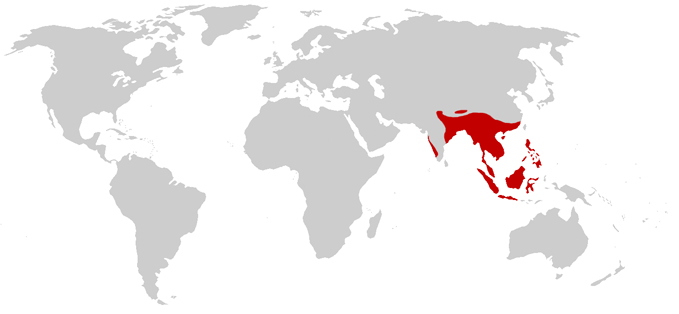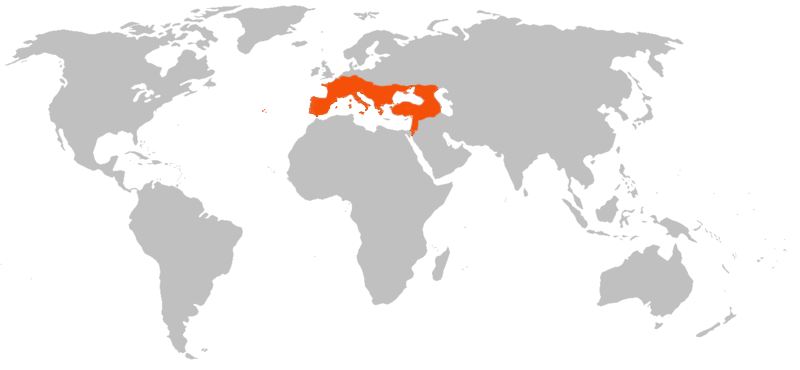You are using an out of date browser. It may not display this or other websites correctly.
You should upgrade or use an alternative browser.
You should upgrade or use an alternative browser.
Challenge: An empire matching the distribution map of a plant or animal
twovultures
Donor
I think that the pre-domestication range of horses in Asia corresponds roughly to the Mongol Empire's borders at it's height, for the obvious reason that where wild horses thrive, so do cavalry-based armies.
Mouse-Eared Bat is pretty much European Rome.
Monarch Butterfly could be a American Empire, or a KGC-controlled US that went to Asia later.
Monarch Butterfly could be a American Empire, or a KGC-controlled US that went to Asia later.
This is an interesting challenge, for it can go from the impossible to the very easy.
The impossible would be trying to make empires and states encompassing the almost universal range of animals like the Grey Wolf, Orca/Killer Whale, Peregrine Falcon, Rock Pigeon.
But then the easy would be creating states (well the challenge is Empire so I do not know if they would qualify) that encompass the range of highly specialized, unique, rare, often endangered species. Examples would be the Indian Lion, Giant Panda, Galapagos Tortoise, Javan Rhino (which all today have their wild populations encompassed within one single state, and historically an empire).
For middle of the road options though, meaning animals which have larger ranges but nothing universal, I'd put forth the "Dominion of the South" or "Empire of Southern Pole", basically an empire consisting of: The Galapagos, coast of South America from Ecuador to Tierra del Fuego and up till Rio de Plata, South Africa and Namibia, Australia, New Zealand, Antarctica, and the plethora of isles and islets that dot the Southern Seas. This should firmly put ALL species of penguins under the same flag.
The impossible would be trying to make empires and states encompassing the almost universal range of animals like the Grey Wolf, Orca/Killer Whale, Peregrine Falcon, Rock Pigeon.
But then the easy would be creating states (well the challenge is Empire so I do not know if they would qualify) that encompass the range of highly specialized, unique, rare, often endangered species. Examples would be the Indian Lion, Giant Panda, Galapagos Tortoise, Javan Rhino (which all today have their wild populations encompassed within one single state, and historically an empire).
For middle of the road options though, meaning animals which have larger ranges but nothing universal, I'd put forth the "Dominion of the South" or "Empire of Southern Pole", basically an empire consisting of: The Galapagos, coast of South America from Ecuador to Tierra del Fuego and up till Rio de Plata, South Africa and Namibia, Australia, New Zealand, Antarctica, and the plethora of isles and islets that dot the Southern Seas. This should firmly put ALL species of penguins under the same flag.
Mouse eared bat is pretty easy, have the Carolingians and Byzantines marry together and recreate the united Roman Empire, then reconquista Spain and the Holy Land. The little sliver of Germany just south of Denmark that is not in the empire could be a Saxon or Frisian country.
The American Revolution failed in 1775. Because of the Revolution in France and then in Europe the British royal family fled to America where they founded the Holy Empire of Britannia.
This empire decides to invade South East Asia in the middle of the 19th century before invading Japan in 2010 for its Sakuradite.
The King Cobra range looks a lot like a very successful Khmer Empire.
I'm out of my depth here, but I think Toungoo Burma would have a better shot. More Indian Ocean access and, if modern era population figures correspond in the slightest to those in the middle ages, a much, much larger population base.
If you ignore its recent introduction into Australia, the range of the dromedary tracks pretty closely with that of the Umayyad Caliphate. Have them expand a bit further south, and you'd basically be done.
If said species is discovered to be several cryptic species, does that mean the empire has to split up?
Do they automatically gain land if they introduce that species elsewhere, and it is invasive?
Etc.
Do they automatically gain land if they introduce that species elsewhere, and it is invasive?
Etc.
If you ignore its recent introduction into Australia, the range of the dromedary tracks pretty closely with that of the Umayyad Caliphate. Have them expand a bit further south, and you'd basically be done.
Why ignore Australia? The Caliphate lives longer and is more stable. At some point they are bit by the exploration bug. While not going a-conquering in South and Southeast Asia, they eventually find an unoccupied (by their standards) land and start settling. There you have it.
Basically Imperialist America. Post civil war the US keeps expanding into Central America and the Caribbean. Spanish American war occurs earlier. It fights a war with Britain taking Canadian border territory and the British West Indies.
And after this time lines version of WW2, it decides to keep the Pacific territories it liberated from Japan, probably in a deal with the USSR.
Last edited:
The Proto-Indo-Europeans unite under a "khan" of their own during an early-ish phase of their expansion, the range of domesticated horses and the borders of their empire matching almost perfectly; the empire doesn't last, but the tale is preserved in legend, a legend that is then proven sort of true (minus all the mythical flourish) by archaeological and literary findings.
Deleted member 114175
Been a while but revisiting this idea
Crowned shrew (Sorex coronatus) distribution:
Frankish empire that never conquered Italy, during zenith of al-Andalus.

Greater white-toothed shrew (Crocidura russula ) distribution:
Surviving Napoleonic empire in ~1850

Blue-footed booby (Sula nebouxii) distribution, assume extra coastline:
A Tarascan thalassocracy connecting the centers of bronze metallurgy in the pre-Columbian Americas

Crowned shrew (Sorex coronatus) distribution:
Frankish empire that never conquered Italy, during zenith of al-Andalus.

Greater white-toothed shrew (Crocidura russula ) distribution:
Surviving Napoleonic empire in ~1850

Blue-footed booby (Sula nebouxii) distribution, assume extra coastline:
A Tarascan thalassocracy connecting the centers of bronze metallurgy in the pre-Columbian Americas

As well as Llamas and Alpacas.Before Colombus, Inca Empire pretty much equaled range of potatoes
Greater white-toothed shrew (Crocidura russula ) distribution:
Surviving Napoleonic empire in ~1850

This could also be a surviving Gallic Empire that expands into Germania
Dying Tiger of the East: The Rise and Fall of the Hu Dynasty
For centuries the light of the East lay firmly within the Hu court, a massive state that once ruled over half of all people on the planet. Born from a small Vietnamese kingdom the Hu would ultimately conquer China, Siam, Majapahit and the Mughal Empire. Ultimately, this growth would sow the seeds for the Hu's ruin as the hostile empires of Europe and Japan would fuel internal dissent and rebellion.
The 20th century would be a painful one for the Hu, losing the first two world wars and completely collapsing after the third one in 1975. The court of the Hu would live on in their largest contiguous territory north of the once semi-independent Goryeo peninsula. The current empress of Hu attempting to revive connections with the remains of the once vast imperial family down in south.
Share:



